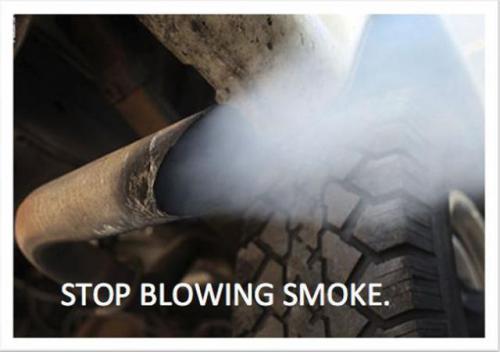
Image Credit:
Will Bailey
I’ve often had students work with images in past semesters, but in those activities I’ve used them as texts for analysis or tools for organization, as when students constructed visual-verbal-aural outlines in Animoto to help them prepare for their formal essays. This semester I decided to have my RHE 306 class focus on using images to aid in invention and construction of a succinct argument. Specifically, I asked them to create a bumper sticker through an in-class activity meant to help them explore commonplaces and introduce them to visual rhetoric. As I note in my lesson plan, students created their bumper stickers, along with a short reflection, in one class period.
Because the activity acted as a bridge into our rhetorical analysis unit, I wanted it to call their attention to basic design decisions like placement, size, color and typeface as well as the rhetorical impact of these elements. Most importantly, I wanted them to focus on how they were responding to or incorporating a particular commonplace in their bumper sticker and crafting a message to accompany the image. To accomplish these goals, I suggested they use PowerPoint or even Word unless they had past experience with more sophisticated image-manipulation software. I found they were familiar with importing images into PowerPoint from making presentations in the past, and that when they had questions about what to do or how to do it, they were able to collaborate with those around them to arrive at a solution.
Using familiar technology in a low-stakes assignment made them feel more comfortable as they were building confidence in their capacity for visual and verbal invention and composition. Though they were uncomfortable at first with what they perceived as a more creative exercise than they’d encountered in most other writing courses, they were able to write copy that employed a variety of very effective rhetorical strategies and convey their ideas in a genre-appropriate way. I was particularly impressed at how they were able to use each other as resources for brainstorming and thinking through how their bumper stickers might be read differently if actually applied to a car.
I believe the added value of this assignment was in how students used familiar software in an unfamiliar way. It pushed them to think about the program’s capabilities and not just the particular rhetorical situations and genres it has become closely associated with. As Stuart Selber says in Multiliteracies for a Digital Age, one marker of students’ functional literacy is “mak[ing] use of the specialized discourses associated with computers” (45), a goal that instructors can help them reach by encouraging them to “appropriate the various discourses of literary technologies” (58). As much as I enjoy showing students the possibilities offered by newer, shinier programs, I found that helping them see alternative uses and greater composing potential in a familiar platform was simple and rewarding.

